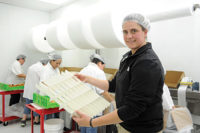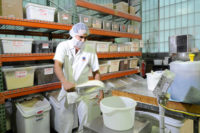Creating cookies to crave






















The Christie Cookie Co.’s national foodservice and mail-order operation in Nashville, Tenn., has really changed from its humble beginnings, when founder Christie Hauck baked cookies out of his kitchen before opening a small retail shop in 1983.
Today, the company has more than 50 employees and runs two production shifts a day, five days a week, on four production lines. Equipped with both a mail-order division and a foodservice channel that distributes its luscious products nationwide and beyond, the company generates at least 288,000 2.5-oz and 500,000 1.45-oz. cookies each day, not to mention all of its other products, which include Triple Chocolate Fudge brownies and colossal, 4-oz. Chocolate Chip cookies that it makes for DoubleTree (by Hilton) hotels. On average, it outputs 3,000 cases of product daily.
The growing firm runs more like a large corporation, which may be one of the secrets to its success. The production operation is always bustling, but has a warm and friendly atmosphere. “Although we operate the facility with big-business ideas, we have never lost the core value of a family business,” explains Fleming Wilt, president. “We’re in the midst of our long-term strategic planning process, which focuses on national branding, Lean Manufacturing and product expansion. And we always concentrate on making the highest quality baked goods.”
That corporate philosophy works. The company’s annual sales are approximately $26 million and counting. Last year, it enjoyed 14% growth and has grown steadily just about every year in its 30-year existence, says Sue O’Donnell, executive vice president and president of the Mail-Order Division.
The substantial cookies in 1.45-, 2.5- and 4-oz. sizes include the Combination assortment of Chocolate Chunk, Chip, Oatmeal Raisin and White Chocolate Macadamia varieties. There are also a Cookie of the Month, muffins, individually-wrapped single cookies and a recently launched collection of chocolate/caramel/toffee candy confections.
The most distinctive factor at The Christie Cookie Co. is the way the cookies taste, thanks to the top-quality ingredients and the care taken to combine them into each recipe. Everything is hand-measured, which gives them a down-home quality, not a mass-produced feeling. “The butter, the eggs, the sugar, the chocolate chips, etc., are all added in by hand,” says O’Donnell. “We don’t use a premix. The products taste like someone made them in their own kitchen. They’re packed in tins one at a time for mail-order sales. That’s what makes this a gourmet cookie and what gives us an edge in the market.”
The cookies are baked fresh for mail-order shipments and processed in various ways for foodservice, depending on customer requirements: They can either be mixed and shipped frozen; prebaked and frozen for thaw-and-serve operations; or, in the case of individually-wrapped single cookies, baked and packed. Most of the products have a six-month shelf life frozen and a three- to seven-day life fresh-baked, depending on the specific product.
Becky Bridges, quality assurance manager, led SF&WB on a tour of the plant, which was producing 4-oz. Chocolate Chip cookies for DoubleTree hotels at the time. Tickets are generated for each order, which are sorted according to various parameters, so that production can be well planned.
Measuring, mixing, forming
First, raw ingredients, such as white and brown sugar, flour and salt are stored in bulk sacks in a three-rack-high warehouse. Nuts and other allergens are clearly marked and separated from the rest of the ingredients.
“All of the cookies contain allergens, such as nuts, but they don’t all have the same allergens,” Bridges explains. “And we probably go through a truckload of flour every week.”
Eggs, butter, most chocolate, milk and other more perishable items are kept in a refrigerated room, as are raisins and cherries. To produce an order, the ingredients are gathered from the warehouse and refrigerated storage and measured by operators in the mixing area, or what The Christie Cookie Co. calls its commissary. This is where the products are mixed into dough, formed, frozen (if applicable) and put on pans for baking (also if applicable). The mixing/processing room houses three stationary mixers, two cookie puck former/cutters and a nitrogen freezer tunnel, among other systems.
Hand measuring of ingredients occurs all day long—as often as 200 times a day. One complete measuring process for a batch yields about 3,000 cookies. The ingredients are added by line operators in precise order to one of the stationary mixers. This step is checked off on a quality-assurance form and is monitored by quality-assurance staff. After the dough is mixed, the batch of dough is transferred from the mixer into one of two puck formers, which produces exact-weight cookies. An operator loads the hopper of the puck system with just the right amount of dough, guided with the help of a mirror installed on the top.
Freezing, inspecting, weighing, casing
Round pucks of dough emerge from the forming system, and at this point, one of two things takes place, depending on the products’ marketing channel: Cookies for mail-order customers exit the forming unit and are placed on pans that are racked and transported to a bank of ovens for baking (more on mail-order processes later).
Cookie dough pucks bound for foodservice customers automatically convey five-across into a cryogenic nitrogen tunnel freezer set at -10 deg. F and are flash-frozen, which takes about three to four minutes.
Next, the frozen pucks exit and gently drop onto the infeed conveyor of a metal detector that checks them for contaminants before they incline and land in the buckets of an elevator. The elevator carries them overhead to a weigh-scale hopper where they’re automatically weighed. When the scale weighs off 15 lb., the pucks drop into a pre-erected corrugated shipping case, lined with a film bag. The filled case is then released from the system and progresses around the corner and out of the room through an opening in the wall.
In the next room, the filled cases shuttle onto a vibratory conveyor that settles the frozen pucks inside before entering a system that automatically tucks in the bag liner, folds the top flaps closed and tapes the top of the case, sealing the flaps. Next, each case is automatically labeled with production identification before conveying to a palletizing area, where operators load 90 of the cases onto pallets. The operators then stretch-wrap the pallet loads and store them in a freezer, ready for shipment. Freezer trucks deliver the loads to distributors and other businesses throughout the country.
“Our quality control technicians check the scales and metal detector, conduct a glove inspection and ingredients verification process, check butter temperature, case weight, puck size and cutting blades, among other steps,” Bridges points out. “Now that our Lean Manufacturing initiatives have been implemented, we’ll be revising some of our palletizing processes and reorganizing our storage areas.”
She adds that a portion of each frozen batch of product is baked off to ensure that the batch bakes properly and that when the product gets to the customer, “it’s just right.”
Production on the first shift lasts eight hours, while the second shift lasts 6½ hours on the plant floor and another 1½ hour for cleaning. “We try to limit ourselves to no more than two changeovers per shift,” Bridges explains. “Usually just a few parts need to be switched for the different cookie sizes, and takes about 20 minutes. If we change from one flavor to another, then we need to check if the allergen ingredients will be changing. For example, if we switch from running peanut butter to chocolate chip, an allergen cleanup must be performed, which takes about an hour. To save time, we plan ahead to group production runs on similar products that have like ingredients.”
Mail order
Pucks formed for cookies bound for mail-order customers, who include corporations and consumers, exit the puck former in the commissary and operators place them on baking sheets, transfer the sheets to racks and move the racks out to a baking area. There, the racks are rolled into one of four rotary ovens that bake them at temperatures ranging from 300 to 460 deg. F. Depending on the product, the large ovens can bake 560 cookies every seven minutes.
After baking, the cookies cool completely and are inspected manually by quality assurance staff before heading into the mail-order packaging/assembly room where operators carefully pack them into tins or other specialty containers.
On one assembly line in the mail-order packing room, clear film bags printed with red stripes and the signature Christie Cookie logo are placed into each gift tin. Next, the cookies (in a choice of three different sizes and quantities) are gently layered according to flavor and a specific packing pattern inside. Operators then twist-tie the bag closed and place foam loose-fill peanuts on top to prevent shifting.
Special insert cards are included with each tin and then the lid is applied. The tins are then sent through an L-bar film wrapper and heat tunnel and a metal detector before the line operators case-pack each one into a printed shipping case, preloaded with bright red foam cushioning on the bottom. Another piece of foam goes on top, and the case is sent through a tape sealer and placed on a pallet for shipping.
“A shipping label featuring a gift message is printed and applied to the case,” Bridges adds. “Each tin gets those three flavors and may also get brownies, if the gift is a cookie/brownie combination. We bake the brownies for mail-order shipments the same way and cut them to size on a cutting machine.”
The mail-order packaging room also incorporates a semi-automatic wrapping line for the single-cookie packs, which fin-seal-wraps each cookie in film from rollstock printed in three colors. The individually-wrapped cookies accumulate on a rotary table before line operators case-pack them.
Orders are shipped within about 24 hours, Bridges says. The just-baked appeal and quick shipment The Christie Cookie Co. employs involves some prep work, which can include pulling the gift tins or other special containers out of inventory, setting up the red-striped bags, preparing shipping labels and insert cards and preparing the custom gift message labels.
“One of our big advantages is that we have the systems and the distribution network in place to get the products anywhere in the country,” adds Jay McKnight, vice president of the Foodservice Division. “That’s something most small food manufacturers may not have. They have good products, but no way to get them to as many consumers as they’d like. We distribute the products through the [one of the nation’s largest redistributors] Dot Foods Company, which gives us access to any frozen food redistributors in the country. The products are also shipped through LTL (less than truckload) common carrier where demand calls for it.”
One taste makes it clear: The cookies can’t arrive fast enough.
Looking for a reprint of this article?
From high-res PDFs to custom plaques, order your copy today!


















